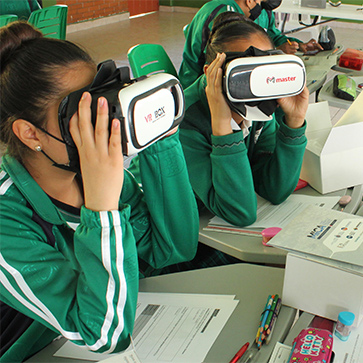Creativity sparks curiosity – even online
María Marcela Vargas Fernández teaches 32 preschool children aged five to six at the Escuela República de Brasil in Santiago, Chile. The pandemic turned her life upside down. Overnight she was faced with the enormous challenge of teaching preschool lessons online.
»As the months went by, more and more children started to log on. The screen is a hive of activity, the classes are incredibly interactive.«
María Marcela Vargas Fernández, Escuela República de Brasil in Santiago, Chile
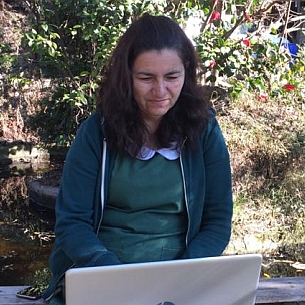
The COVID 19 pandemic has made the need for digital teaching and learning materials in school lessons undeniable. Figures from UNESCO indicate that some 160 million students in Latin America alone were impacted by school closures. In response to the need for urgent action, Siemens Stiftung joined forces with partner institutions and education ministries in Latin America to launch the STEM Education for Innovation initiative. With financial support from Siemens Caring Hands e. V., the initiative enabled access to innovative educational formats for STEM classes in seven countries. A series of interviews with educators provides a glimpse of how everyday life has changed in kindergartens and schools.
STEM Education for Innovation
Learn about the 14 projects in the Latin American STEM education initiative.
Thanks to Experimento I 4+ and the extended resources available through the STEM Education for Innovation education initiative, not only did Vargas Fernández succeed in motivating more and more children to engage with the online lessons, she also encouraged their families to get involved with early childhood education – an achievement that was especially challenging considering the social structure of the families. In addition to ideas and instructions for teaching, the education initiative has also provided Marcela with access to a network of teachers across Latin America. Marcela now collaborates with them to make online preschool lessons meaningful and effective –for both the children and their families.
My profession – a life mission
I am an early childhood educator. In Chile, this involves completing a five-year program at university. My profession is a vocation – my life’s work – and I am very motivated. At the moment, I am working at the Escuela República de Brasil in Santiago, Chile, a learning community linked to a center that dates back to the 1990s at the University of Barcelona studying theories and practices for overcoming inequality.
It is a project based on a series of successful educational activities that aim for social and educational transformation in the community, which begins at school but includes everything that happens around it. Based on dialogic learning, community participation in education, and inclusive practices, we want to provide effective, quality education for all children and adolescents that also ensures equality and social cohesion.
There are 14 grade levels at my school, from children entering preschool to students graduating from secondary school. School education begins with a transitional level before preschool with 30 children and a preschool with 32 children. I am responsible for the children between the ages of five and six, of which there are 32. Among them are 13 Chilean and 14 Venezuelan children, one Colombian child, three Peruvian children, and one Peruvian-Colombian child. Many of the children of migrant parents were born in Chile.
I enjoy sitting together with the children on the floor of the nursery and working with them using our hands, feet, and full bodies. We paint and explore a lot of new things together, such discovering and learning about small animals in nature.
I enjoy sitting together with the children on the floor of the nursery and working with them using our hands, feet, and full bodies.
The COVID-19 pandemic
The pandemic presented enormous challenges for me. I never imagined we would live through such a situation. Nurseries and schools were closed, everyone had to stay at home, and we were isolated from each other for long periods.
Overnight we had to switch to a virtual world.
Since March 2020, freedom of movement in Chile has been severely restricted. Police permits can be obtained to give parents the option to go outside with their children for a few hours. The distancing rules are now slowly being eased, but for more than a year, we could only meet under strict restrictions, with scarcely any direct contact possible. ‘Normal’ was a completely different. Overnight we had to switch to a virtual world. This was an enormous challenge for me. Like most of my colleagues, I wasn’t prepared. From one day to the next I had to learn how to contact the children virtually so their early childhood training and education could take place.
There was a lot of stress and anxiety at first. Would I be able to manage it? I am a hands-on person, tactile and sensory by nature. Although everything became digital, but ‘learning by doing’ was still important for the children. I had to be very creative, but I always say: The glass is half full and not half empty. We have adapted to the crisis and developed new methods. This would not have happened were it not for the pandemic.
Lessons and games during the pandemic
We were very tentative during the first year of the pandemic. It was difficult to make contact. Nobody gave us any real guidance and I was worried if we could manage it at all.
In the beginning, my main concern was getting the children a computer, laptop, or mobile phone.
When the pandemic hit, I left Santiago and went to stay with my mother in the countryside. I connected digitally with the children in my nursery class every day. I started out with seven or eight children; participation was often determined by the particularities of each family: A computer – if one was available at all – would often be shared with siblings. The same goes for mobile phones and their limited data. This meant that, in the beginning, my main concern was getting the children a computer, laptop, or mobile phone. I asked around everywhere to see who might be willing to donate a device. I also tried to secure public funds but that turned out to be more difficult. There are simply too many children in need of support.
It’s ‘full Zoom’ for us this year. Unfortunately, my school did not purchase a license, so we are working with the free Zoom version. This means our lessons are at most 40 minutes long. While this may seem like a very long attention span for five- to six-year-olds, we were surprised to discover that as the months went by, more and more children started to log on. The screen is a hive of activity, the classes are incredibly interactive. Very often, the children would like to stay together online for much longer – these days, this simple audio-video communication really does enable genuine social contact, which is so important. I teach three modules each day with the students, two on topics they need to learn at their age and one module on psychomotor exercises. We often go well beyond the allotted time together because the children always want to do more.
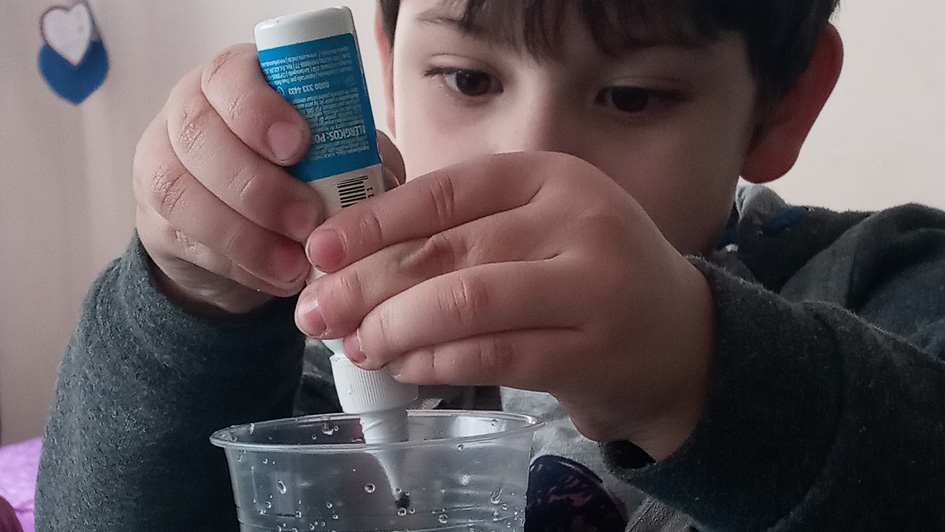
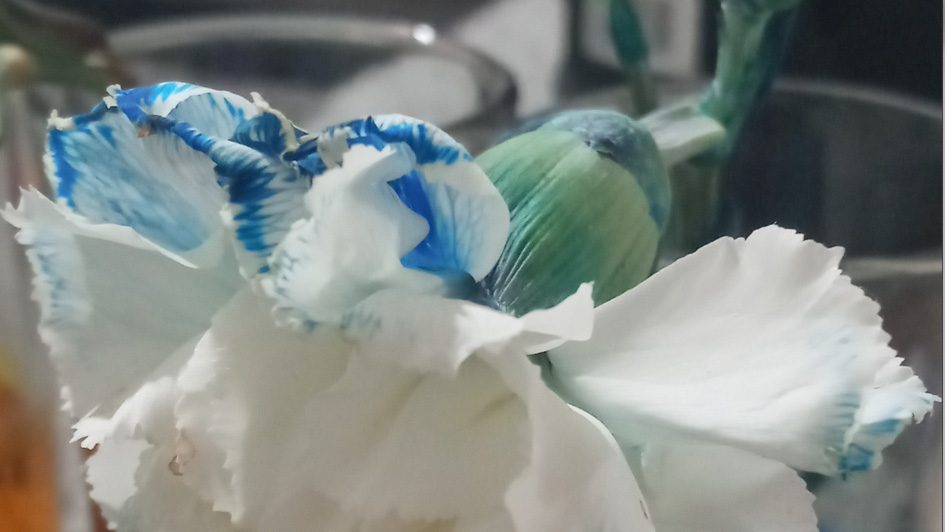
I have been working with Experimento since 2015, and it has proven invaluable during the current crisis.
Thankfully, more topics, media, and formats are now available. They provide me with ideas for planning lessons. I have been working with Experimento since 2015, for example, and it has proven invaluable – during the current crisis, too. I’ve used the program’s modules and experiments with my students for many years, starting with exploratory learning. This allows the children to really develop their curiosity, creativity, and spontaneity. I can teach them so many things about objects, plants, animals, and other phenomena in their immediate surroundings.
One experiment I did showed the children the properties of air using very simple materials that their families would have at home. We crushed a disposable plastic bottle and observed how the bottle and its contents react depending on whether the cap is open or closed. From this the children discover that although you cannot see or feel air, it is all around us. In another experiment we added various items to a glass of water – gravel, oil, earth, sand – and watched how the different materials mixed with the water. This helps the children discover that it is almost impossible to separate these items from the water, which helps them understand how water becomes polluted.
Experimento
Our international educational program Experimento offers training in methodologies, teaching materials and specific experimental materials for all ages.
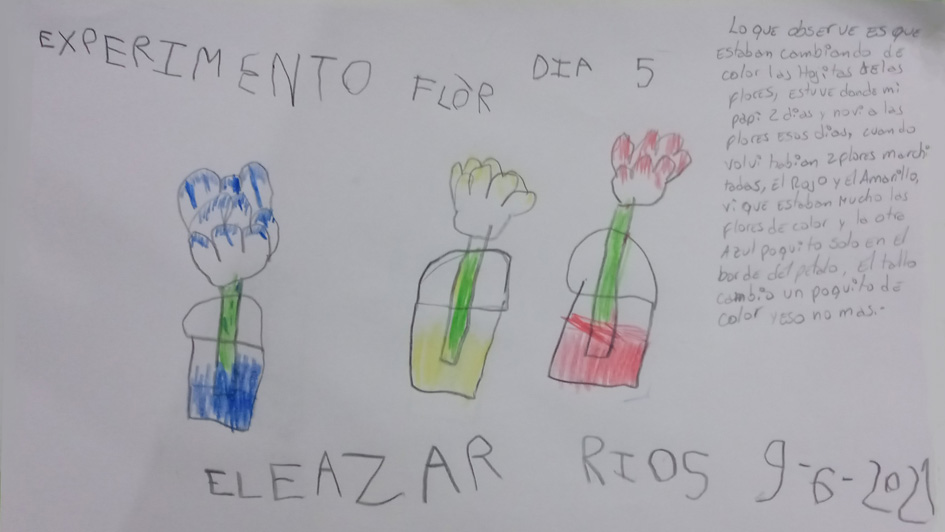
I have been familiar with Experimento | 4 + for many years, but I have also worked with other media from Siemens Stiftung and from ICEC, the national STEM continuing education program. I also work in two teacher teams on developing blended learning materials, which connect analog and digital content, for the education initiative STEM Education for Innovation, so I am familiar with many resources that are now being put to very good use.
The sense of shared learning is also important and in need of reinforcement during lessons.
These days, the Zoom sessions have expanded to include around 20 children. Beyond the subject matter, there are things such as emotions and the sense of shared learning that are also important and in need of reinforcement during lessons. I’ve even surprised myself: I never thought I would be able to use digital media and tools like I do now. I had never shot and edited videos, never taught lessons or led play sessions via Zoom, and certainly never combined programs and apps such as PowerPoint, Canvas, and others. But it really works! I am constantly learning and trying out new things.
At least once a week, we have science lessons that are combined with other topics, especially math. I have also introduced synchronous and asynchronous teaching modules. These have the children completing certain tasks together with adults before we then come together again and discuss the findings online. This is an example of a typical math lesson for preschool children via Zoom: at this age, it is important that the children know their numbers, learn how to count and recognize numbers, and understand that numbers can be used to solve problems.
Zoom began to buzz.
I told the children about my mother’s birthday, using a digital format that I had created to show the numbers one through 80. I left a spot free at 76 – that is her age. Then I asked the group: “What do you think, how old is my mother today?” Zoom began to buzz. The children tried in all different ways to explain which number it might be. One child simply counted from one and arrived at the number. Others looked at the tens. I’m sure a parent or two was whispering in the background, but overall the children came up with very creative options.
Then I explained the difference between 6-7 and 7-6, and of course we discussed the meaning of birthdays and what it means to become a year older. We measure learning success or progress differently during the pandemic and these changing times for education. We use new formats, media, and educational strategies. It’s important to take this into account. But it feels wonderful when you hear a small voice over Zoom saying: “Tía, me gustó mucho esta clase” (“Auntie” – which is how children address women to express respect – “I really enjoyed this class.”).
The role of parents
One of the benefits of the current situation is that parents and families now appreciate what their children are learning and experiencing in preschool. They take part, observe, and provide support. Parents learn to understand topics in pedagogical and didactical terms and increasingly see themselves in a role that involves sharing responsibility and actively supporting their children. More parents are enthusiastically joining in, if time permits. This leads to completely new and exciting teaching and learning experiences.
Many parents correct what their children say or give them the answers so they ‘do everything right.’ In such cases, I intervene and make it clear to the parents that making mistakes is extremely important for the learning process, just like trying things out and providing ideas and input. This is the only way that we can work out problems and solutions in the group.
Parents learn together with their children, including many things they were not familiar with before. They learn that preschool is not about playing. Instead, they see that in many respects, an important learning process is taking place. Early childhood learning paves the way for all the discoveries and processes that are so critically important later in life. Parents have become part-time teachers as a result of the pandemic. Their homes have become classrooms. Anyone involved with the topic of education will recognize this.
Parents have become part-time teachers as a result of the pandemic.
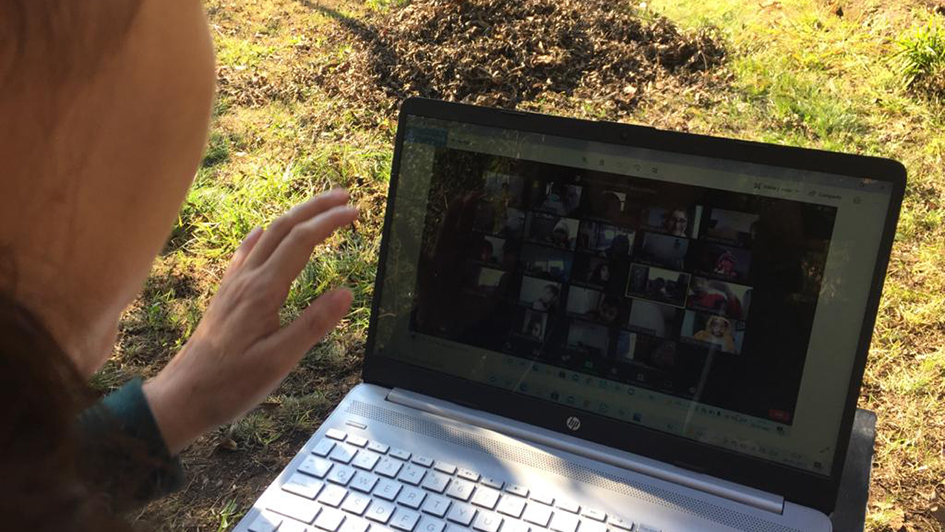
We can’t assume that everything can suddenly switch to digital and virtual.
Like never before, I got to know the family backgrounds of my students. These are anything but simple, in many cases. Many children are Venezuelan, Bolivian or Colombian rather than Chilean. In almost every family, there is a lack of steady and sufficient income. Most do not have enough money, and a solid social fabric is missing.
In one case, a mother works at the wholesale market. But with no childcare, she takes her child with her to the vegetable stall where she works. Imagine what a preschool lesson over Zoom is like for this child? The child is often absent or can’t participate because no device is available or working, or because the mother has no time to provide support. Previously the child would have been sent to preschool and the mother would have gone to work. The child would have gotten meals at preschool. All of that is now gone.
We can’t assume that everything can suddenly switch to digital and virtual with the current crisis. It’s not just about connectivity or the device needed to access the network. There are many other factors involved in ensuring education can take place.
Findings
What I find is that despite the lack of direct social contact, we are also gaining an insight into the reality of children’s lives through our contact with the parents. I observe more than perhaps ever before. From time to time, the children ask me who belongs to a community. They ask questions about their preschool or school – places they don’t know but where they definitely want to go.
I observe more than perhaps ever before.
‘What is the woman called who would cook our meals if we were there?’, ‘Who is the man in overalls who looks after the school and sweeps every morning?’, ‘Who wrote our workbook that we use to learn things?’ Once I heard the questions, I organized interviews and invitations so that the children could ask their questions directly. The author of the official textbook for early childhood education was invited – the book is one of the resources we teachers use that is in line with the national curriculum for preschools. The children asked the author their questions, and he was thrilled that the little ones had such an interest in everything.
The education initiative allows us to work together on projects and find solutions.
The education initiative STEM Education for Innovation has put me in touch with other teachers from preschools and kindergarten, but also from primary schools and even secondary schools. They come from other regions, sometimes even from different countries. I am glad I have been able to increase my contacts with colleagues so significantly. That’s another upside to this terrible crisis.
The education initiative allows us to work together on projects and find solutions. Our different practical experiences are important for developing media and educational guidelines. Who would have thought that I would be involved in a project with Siemens Stiftung, the Colombian Ministry of Education, and a Colombian colleague within an OEA (Organization of American States) project? This group works closely with the Siemens Stiftung’s Red STEM Latinoamérica network. Today I am part of this network and continue to develop alongside the other members.
I am also very impressed at the interaction among my students. The class of 2021 was not in preschool before the pandemic. They are only starting this year; their first contact with preschool lessons and the start of a 12-year education chain is taking place online. They have never been together in preschool like all other children, not even for a single day. It’s all online for them – that is the reality of preschool today.
Despite this, it is truly amazing that some of the children recognized each other when they met in person – at a safe distance – for the first time in a long while at Parque O’Higgins, a large park in downtown Santiago.
September 2021
STEM Education for Innovation
Together with partners in Argentina, Brazil, Chile, Colombia, Ecuador, Mexico, and Peru, we adapt STEM teaching and learning content for digital use in the classroom. The initiative is supported by Siemens Caring Hands e.V. and the German Federal Foreign Office.
